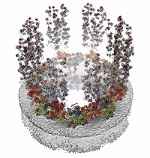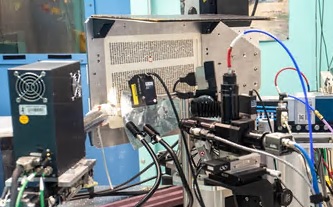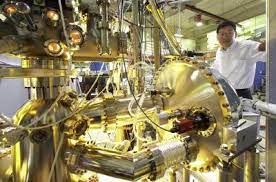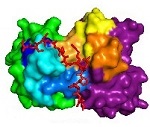
Science Highlight
How Epstein-Barr Virus Infection Triggers Multiple Sclerosis – Contacts: Tobias Lanz and William Robinson (Stanford University)
Autoimmune diseases are caused by the immune system mistakenly attacking the body’s cells. In people with multiple sclerosis (MS), lymphocytes and antibodies attack cells in the central nervous system (CNS). The reasons for immune system malfunction in MS are unknown, but may be related to Epstein-Barr virus (EBV) infection. If antibodies activated due to their ability to bind an EBV antigen can also bind proteins in CNS cells, autoimmune disease could result. A team of researchers investigated the connection between MS disease and EBV infection by identifying antibodies from MS patients that bind to both cellular and viral targets and analyzing the structural basis of the antibody-antigen binding. Read more...
More SSRL-Related Science
A New Leap in Understanding Nickel Oxide Superconductors
Excerpt from SLAC News Article by Glennda Chui
A new study shows that nickel oxide superconductors, which conduct electricity with no loss at higher temperatures than conventional superconductors do, contain a type of quantum matter called charge density waves, or CDWs, that can accompany superconductivity. The presence of CDWs shows that these recently discovered materials, also known as nickelates, are capable of forming correlated states – “electron soups” that can host a variety of quantum phases, including superconductivity, researchers from SSRL and Stanford University reported in Nature Physics(link is external).
“Unlike in any other superconductor we know about, CDWs appear even before we dope the material by replacing some atoms with others to change the number of electrons that are free to move around,” said Wei-Sheng Lee, an investigator with the Stanford Institute for Materials and Energy Science (SIMES) who led the study.
The research team carried out experiments at three x-ray light sources – the Diamond Light Source, SSRL and ALS. Each of these facilities offered specialized tools for probing and understanding the material at a fundamental level. Read more...
X-rays Help Researchers Piece Together Treasured Cellular Gateway for First Time
Excerpt from SLAC News Article by David Krause

Your body is made of close to 100 trillion cells that keep you healthy and alive. Each cell has billions of parts of its own, all of them working in tandem to keep life’s processes moving.
One vital component of a cell is called a nuclear pore, which acts like the doors and windows in a house – they allow important things, like RNA and proteins, to enter and exit a cell’s nucleus. Without nuclear pores, your cells, and everything else in your body, would shut down. Until now, scientists have not seen exactly how nuclear pores are built and how their many parts function.
Enter a team of researchers from the California Institute of Technology (Caltech), led by André Hoelz, professor of chemistry and biochemistry and faculty scholar of the Howard Hughes Medical Institute (HHMI). After almost two decades of persistence, researchers successfully mapped the atomic structure of the nuclear pore complex (NPC) by determining the structures of its many components and fitting them together. Seeing how the NPC fits together in cells furthers our understanding about how cells work and will potentially lead to new treatments for certain cancers, autoimmune and neurodegenerative diseases, and certain heart conditions. Read more...
Did Gutenberg Really Invent Printing? Scientists Use X-ray Light to Compare Similarities in Ancient Asian and Western Texts
Excerpt from Mercury News Article by Lisa M. Krieger

The printing press, one of the most important inventions in human history, was developed within a couple hundred years of each other by two very different cultures, separated by vast distances.
A new research study aims to shed light on this enduring mystery by comparing the chemicals in precious pages of two mid-15th century documents: Germany’s Gutenberg Bible and early Korean Confucian texts. X-ray fluorescence imaging was done at SSRL to study residues on the pages left by metal typefaces. The findings could suggest whether the idea of movable type was conceived independently or shared between the regions by ancient traders.
This research is part of an international project led by UNESCO. Fragile pages from the ancient documents were on loan from archives in Korea and Stanford Library, as well as private collections. The findings — from SSRL and other research institutions using different approaches — will be shared at a conference next April at the Library of Congress.
♦ Mercury News article(link is external) ♦ CNET video documentary and article(link is external) ♦ Tiny Mic, Big Lab episode(link is external)
Awards and Honors

Hendrik Ohldag Elected 2022 AVS Fellow
AVS Fellows are Platinum Members who have made sustained and outstanding technical contributions in areas of interest to AVS. Hendrik Ohldag, LBNL, has been elected “For exploring complex magnetic phenomena using novel x-ray techniques with unprecedented spatial and temporal resolution.” He previously held a joint appointment between the ALS and SSRL.
See 2022 AVS Awardees(link is external)
60th Birthday Symposium Honoring Zhi-Xun Shen's Contributions

An all-day symposium was held recently to mark the occasion of Zhi-Xun Shen's 60th birthday and to celebrate the many impactful contributions that he has made to high-temperature superconductor research during his career at Stanford. His ties to SSRL go back to the 1980s when he was a graduate student in Ingolf Lindau's group conducting experiments on an earlier iteration of Beam Line 5.
Dr. Shen's work has been recognized by important awards, including the Centennial Lecture of the American Physical Society, the Kamerlingh Onnes Prize; the E.O. Lawrence Award; the Oliver E. Buckley Prize; Einstein Professorship Award. In 2015, Dr. Shen was elected as a member of the National Academy of Sciences. In 2017, he was elected as a fellow of American Academy of Arts and Sciences, and a foreign member of the Chinese Academy of Sciences. Furthermore in 2019, he was named William and Flora Hewlett Foundation Fellow at the Radcliffe Institute for Advanced Study and the Loeb Lecturer of Physics, Harvard University. Dr. Shen was recognized in 2020 by being named Tage Erlander Guest Professor by the Swedish Research Council and KTH Royal Institute of Technology, Sweden.

Nishikawa Tetsuji Prize Awarded to Xiaobiao Huang
Xiaobiao Huang has been awarded the Nishikawa Tetsuji Prize “For his contribution to the field of particle accelerators, especially in the domain of accelerator design and operation, model-independent beam dynamics analysis, beam-based optimization and control.”
Events
SSRL/LCLS Users' Meeting, September 26–30, 2022 — virtual, no registration fee
Advance registration(link is external) is required to participate in our joint SSRL/LCLS Users' Meeting on September 26–30, 2022. Due to ongoing Covid-related precautions, the meeting is now virtual with no registration fee to attend. This annual meeting is a unique opportunity to gather together the light source community in a single scientific event that includes numerous presentations in the plenary, poster, and parallel sessions. Participants can learn about current/future facility capabilities and the latest user research and discuss science with colleagues from academia, research laboratories, and industry worldwide.
Plenary Sessions & Workshops - The plenary session on September 27 will include a welcome from SLAC Director Chi-Chang Kao, facility updates, and town hall discussion with the LCLS and SSRL Directors, Mike Dunne and Paul McIntyre, and keynote talks from John R. Helliwell (University of Manchester) and Linda Young (Argonne National Laboratory). On September 29, the plenary session will include young investigator talks and award presentations. Additionally, over 20 parallel workshops(link is external) will be held throughout this week-long event.
Poster Session - Presenting a poster is a great way to share your latest research advances and find out what's new from other users. This year, we are asking that just one individual register to present for each poster. Posters should be based on recent results from research done at LCLS, MeV-UED, SSRL, or the Stanford-SLAC Cryo-EM facility. Posters based on experimental results from LCLS and SSRL are eligible to compete for a Joe Wong Poster Award or a student BioXFEL award sponsored by NSF-supported BioXFEL Science and Technology Center. Poster abstracts are due September 9. See the Poster Session(link is external) page for more details.
Visit the 2022 SSRL/LCLS Users' Meeting website(link is external) for more details about the planned events and to register.
ULITIMA 2022 - Ultrafast Imaging and Tracking Instrumentation, Methods and Applications Conference, SLAC, October 3–6, 2022
ULITIMA 2022 website
The 2022 SSRL Summer School on Synchrotron X-ray Absorption Spectroscopy (XAS) and Imaging will be hosted remotely between October 25-28, 2022 via online zoom sessions over 4 days. This school will follow a new format that has been developed to reach a large audience and address targeted questions about X-ray data collection, analysis, theoretical correlation and presentation. Lecture materials are posted on the SSRL summer school youtube channel(link is external). Visit the summer school website for more information and to register.
Announcements
Submit Nominations for the SSRL Users’ Executive Committee by September 16
We welcome candidates interested in standing for election to the SSRL Users Executive Committee (UEC). The SSRL UEC provides an organized framework for interaction between the SSRL scientific user community and SSRL Management. We are currently seeking nominations from the Environmental/Geosciences, Biospectroscopy/BIO SAXS and Macromolecular Crystallography communities. The SSRL UEC meets periodically throughout the year to plan the Users' Meeting in coordination with the LCLS UEC, select recipients for several awards, provide input to SSRL management on topics of interest to the user community, and to raise awareness about SSRL capabilities, user science and accomplishments to a broader audience. UEC elections are held annually in conjunction with our Users' Meeting. Nomination form
Postdoctoral Opportunities at SSRL
SSRL scientists are looking for post-doctoral candidates for the positions listed at Careers at SLAC.
New Guest House Booking Site
The Guest House at SLAC has a new online reservation link. The look and feel is a bit different, but users will still book through the SLAC User reservation link(link is external) that now offers the option to pre-pay for rooms. To access the user rooms, enter the user group (e.g., SSRL), Experiment/Reservation Year (2022, 2023), Experiment/Proposal Number, and Proposal Spokesperson.
User Research Administration
Beam Time Requests
- Macromolecular Crystallography - September 1, 2022 (Oct–Feb cycle)
- Xray / VUV - November 1, 2022 (Feb–Apr cycle)
Proposal Deadlines
- Xray / VUV - November 1, 2022
- Macromolecular Crystallography - December 1, 2022
- CryoEM biology-related proposals for the S2C2 program are due on the first day of each month and are being reviewed on a monthly basis.
Submit beam time requests and proposals through the User Portal.
The Stanford Synchrotron Radiation Lightsource (SSRL) is a third-generation light source producing extremely bright x-rays for basic and applied research. SSRL attracts and supports scientists from around the world who use its state-of-the-art capabilities to make discoveries that benefit society. SSRL, a U.S. DOE Office of Science national user facility, is a Directorate of SLAC National Accelerator Laboratory, operated by Stanford University for the U.S. Department of Energy Office of Science. The SSRL Structural Molecular Biology Program is supported by the DOE Office of Biological and Environmental Research, and by the National Institutes of Health, National Institute of General Medical Sciences. For more information about SSRL science, operations and schedules, visit http://www-ssrl.slac.stanford.edu.
To unsubscribe from SSRL Headlines, just send an e-mail to listserv@slac.stanford.edu(link sends e-mail) with "signoff ssrl-headlines" in the body.
To subscribe, send an e-mail to listserv@slac.stanford.edu(link sends e-mail) with "subscribe ssrl-headlines" in the body.
Questions? Comments? Contact Lisa Dunn(link sends e-mail)





